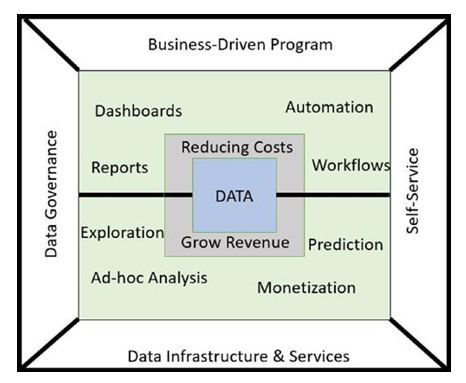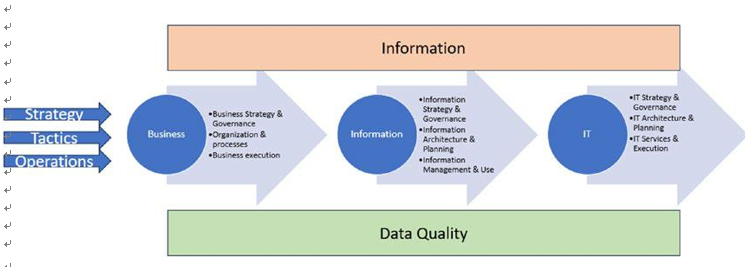
Data Strategy – Business Intelligence
Data Strategy
A data strategy is defined as a set of choices and decisions that will guide and enable a high-level course of action to achieve high-level business goals.
Data strategy has the following purposes:
• Alignment with business and providing guiding principles
• Data strategy defines the vision, mission, and goals of the data
management program. The execution of a data strategy is about making strategic decisions about the individual areas of data management, like Big Data, data quality (DQ), document and content management, data warehousing (DW), data integration (DI), reference and master data, storage and operations, modeling and design, and data security, through tools, technologies, and processes.
• Create a communication strategy for sponsors and stakeholders, and define success factors for the data strategy program.
• The main goals of a data strategy program are to either focus on running operations or focus on growing the business.
Focusing on the growth of business aspects tends to increase focus on analysis, which allows one to see ways to increase business growth through innovation by data exploration and seeking of patterns, and intent the ability to predict results and generate new insights and innovations.
Focusing on running operations requires standard and production reports using reports, dashboards, automation, and workflow to optimize business processes and increase performance.
• Reconcile contradictory points of view.
Figure 7-7 demonstrates the data as a bullseye of business-driven, self-service, data governance, and data infrastructure and service programs to either grow revenue or reducing costs.

Figure 7-7. Data as bullseye value
The main goal of data strategy is to balance and reconcile two contradictory points of view. This helps provide direction to efforts. However, balancing this depends on many factors, like industry, organization culture, business strategy, and so forth. The following are examples:
How much to focus on regular operations versus how much to focus on innovation
Where and how much to centralize versus how much to decentralize. Note how many and how much process to centralize.
How much to focus on speed versus how much to focus on standards. Note that the absence of standards would increase the speed of implementation temporarily. Increasing the standards provides consistency long term.
How much to focus on self-service versus how much to focus on governance. Note that too much governance across processes leads to increased dependence on IT processes.
How much and agility versus architecture. For example, in the absence of standard architecture, users have the flexibility to create schemas as required by user. However, the presence of
architecture standardizes the way data is arranged in systems, which increases predictability and sustenance.
In both cases, it needs to sync up with business strategy. The Amsterdam model— also called a nine-cell model—is used to synchronize business with information and subsequently with information technology (IT). This model has three columns representing business, information, and technology. The three rows introduce an intermediary level between strategic and operations.
Figure 7-8 demonstrates the business, information, and technology alignment with strategy, tactical, and operations.

Figure 7-8. Strategic alignment matrix
The term strategic alignment references tactics deployed and how operational level should be aligned with business strategy.
IT strategy and governance should be aligned with information strategy and governance, and both should be aligned with business strategy and governance. IT architecture and planning should be aligned with information architecture and planning, and both should be aligned with organization processes. Similarly, IT services and execution should be aligned with information management and use, and subsequently it should be aligned with business execution at the tactical level.
Figure 7-9 demonstrates the Amsterdam model point of view for the alignment of strategy, tactics, and operations, and the flow of alignment from business to information and to IT.

Figure 7-9. Amsterdam model point of view 1
The requirements and direction flow from business to IT through information. There are three levels in increasing order of detail: strategy, tactics, and operations.
Figure 7-10 demonstrates the Amsterdam model point of view for strategy, tactics, and operations, and their relationship with business, information, and IT.

Figure 7-10. Amsterdam model point of view 2
Typically, data strategy comes under data management program and is involved in data management program strategy and in planning for maintaining and improving data quality, integrity, security, and access.
Business plans use information to competitive advantage and to support enterprise goals. Data strategy inherently derives data needs/requirements that should meet business goals and sync up with business strategy.
Guidelines for data strategy are as follows:
• Create the vision for data management program and initiatives.
• Create a business case to demonstrate the qualitative and quantitative value for business and business sponsorship.
• Create guiding principles from management perspective.
• Create the mission and long-term directional goals of data management.
• Create measures to quantify success for data management. These measures should be SMART (specific, measurable, actionable, realistic, and time-bound) for both the short and long term.
• Create descriptions of data management roles, responsibilities, and decisions to be made by individuals.
• Create scope and high-level data management implementation roadmap for next three to five years (projects and action items).
• Describe all the technical and non-technical decision-tracking issues impacting strategy.
Archives
- August 2024
- July 2024
- June 2024
- May 2024
- April 2024
- March 2024
- February 2024
- January 2024
- December 2023
- October 2023
- September 2023
- August 2023
- July 2023
- May 2023
- March 2023
- January 2023
- December 2022
- November 2022
- August 2022
- June 2022
- April 2022
- March 2022
- January 2022
- December 2021
- October 2021
- August 2021
- June 2021
- April 2021
- March 2021
- January 2021

Leave a Reply